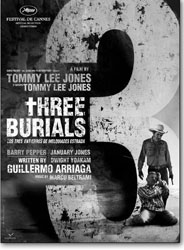| ||
A powerful fable by Judith Reynolds For all the scenic grandeur of “The Three Burials of Melquiades Estrada,” a few trite words from a TV soap opera link this dark film to the American Dream. “We’ll be happy again, Johnny. Don’t cry.” Such false comfort spills out of TV sets at odd intervals: during casual trailer sex, in a bar and beside a truck in spacious Big Bend country. The irony couldn’t be more piercing as doomed characters seek some kind of happiness near the U.S.-Mexican border. In his directorial debut, Tommy Lee Jones aims high at the great tradition of the Western as fable. Jones and screenwriter Guillermo Arriaga (“21 Grams”) weave a tragic tapestry of friendship, disaster and determination. Ranch manager Pete Perkins (Jones) befriends Melquiades (Julio Cedillo), an illegal Mexican worker. Their father-son relationship deepens with shared interests until one day Melquiades is accidentally shot and left for dead in the desert. Perkins learns that Mike Norton (the extraordinary and underrated Barry Pepper), a rookie border patrolman, accidentally killed his Mexican friend. In pursuit of justice, Perkins also learns that Sheriff Belmont (Dwight Yoakam) won’t pursue charges. In one of several flashbacks, Perkins promises to honor Melquiades’ wish to one day be buried at home. The wish and the promise push Perkins into vigilante justice. The wish, promise and hidden murder also propel the film squarely into the realm of mythopoeia.
Perkins kidnaps Norton and makes him dig up the body for reburial in Mexico. With Melquiades’ body and the prisoner Norton strapped onto horses, Perkins begins a long trek south, back across the contentious border. In spectacular desert country, the party encounters a series of mythic types: a blind homesteader, a healer and herdsmen. Powerful and unexpected events bring the journey and the film eventually to a remarkable ending, not to be given away here. Well-constructed subplots underscore the theme of the American Dream that haunts the film. There’s persistent conflict at the border as illegal immigrants stream across. Life in a desolate town offers little escape from boredom, but locals dream of and find versions of happiness. But despite its powerful story, superb acting and a strong sense of place, the picture is not without flaws. Jones decided against a straight narrative. Flashbacks and choppy intercutting introduce characters as if they were shards of pottery. At midpoint the pieces finally fall together, although some bits fall away. There is considerable violence bordering on cruelty. At risk is audience sympathy shifting toward Norton, the bully turned hostage. Many scenes embrace the grotesque as Perkins forces Norton to literally confront the dead. And too often Jones mumbles his way through important lines, an unfortunate example of the actor-director needing a second opinion. With songs by Merle Haggard, Hank Williams and Roger Miller, the sound of the Sands Diner in Van Horn, Texas, however, is just right. And so is the mysterious introduction of a little girl playing Chopin on a tinny piano in a Mexican bar. This strange, poetic scene locks in the mythos of the film as Perkins gets drunk, makes an astonishing phone call, and comforts, once again, the body of his dead friend. All this makes “Three Burials” a flawed but memorable film. •
|

